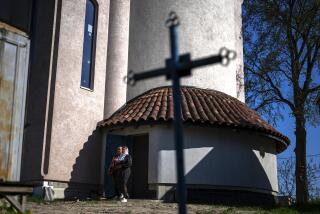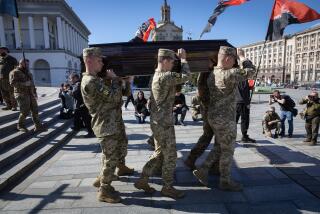Roots Prove Stronger Than Radiation--and Town Lives : Chernobyl: Ukrainian villagers return to homes in disaster ‘Zone.’ Many know little of the dangers.
- Share via
ILINTSY, Ukraine — On the surface, it seemed an idyllic tableau of Slavic spring. Gray-haired grandmothers lolled in the sun-splashed street, men gabbed on benches and a stork preened in its nest atop a brick water tower.
But Ilintsy, population 300 or so, is no ordinary town, and its people are committing either a supreme act of faith or folly.
A legal ban and barbed wire notwithstanding, these Ukrainians have returned to the homes they were forced to evacuate after the Chernobyl disaster. Simple farm workers in the main, they dismiss talk of radiation danger as pseudo-scientific buncombe.
“We have come back to our own earth, and we are not afraid of anything,” shouted Olla Veresenko, a leather-lunged 60-year-old who wore her white apron into the street. “Anybody who says people have died from radiation is lying!” she roared. “We don’t believe it!”
Ilintsy is inside the circle that was drawn 18.6 miles around Chernobyl and emptied of its 160,000 people after the accident. That many of its inhabitants have returned to their small, one-story wooden homes is horrifyingly atypical but a sign of the troubles that still swirl around Chernobyl.
Six years after the worst accident in the history of nuclear power, most Ukrainians are still poorly informed about its impact on their health and lives and distrust most official information--not surprising since a disinformation campaign was once masterminded by the Kremlin itself. And still living in a poor, rural society, people in most irradiated regions do not have access to radiation meters to check the dangers for themselves.
No one is legally supposed to live in what is known simply as “the Zone.” But police Maj. Pyotr L. Gunya said that more than 1,000 evacuees have now come back, some sneaking through fallout-dusted fields and forests after being turned away at the fenced-in area’s five checkpoints.
The Zone boasts two other distinct social strata: There are thousands of workers ready to risk the consequences of working 15-day shifts in increased radiation in exchange for huge pay bonuses, and there are Mad Max-style bandits ready to steal anything, including irradiated vehicles, for resale outside the area.
Ilintsy owes its good fortune to the whims of the winds during the Chernobyl fire. Very little fallout from the blazing No. 4 reactor settled on this quiet farming village. The quantities of especially dangerous isotopes such as plutonium 239 and plutonium 240 appear to be insignificant.
A gamma-ray detector held to the loamy soil here reads only 31 emissions from radioactive particles in a minute. In a heavily contaminated village such as Bober, which is outside the Zone but had to be evacuated, the count runs 1,000 and higher.
What the people of Ilintsy have retained from this was summed up by Maria Struk, 60, a handicapped collective farm worker: “They took us away and deceived us. They told us it was dangerous here, but a military hospital was set up here, and they even brought children to be treated.”
About 1,300 people lived in Ilintsy. Elderly men and women make up most of those who have come back, although there are also at least four young children, two of whom attend school in the town of Dibrova outside the Zone.
When an American reporter showed up on the town’s single street, a good part of the population turned out to voice frustration and anger. Listening to what they went through as refugees, it was hard to fault them for coming back.
For instance, the village was assured that its residents would be evacuated to a single place, so that human ties woven over generations would remain intact. But the people were split up and sent to three separate locations.
Elsewhere in Ukraine, people avoided them, fearing that anybody who had lived near Chernobyl was radioactive. In Kiev, residents didn’t want evacuees buried in their cemeteries, and schoolchildren avoided their new classmates as if they were diseased.
Some villagers spent the winter near Kiev in homes so hastily and shoddily built that 69 of them collapsed when the spring thaw came.
After that first winter of 1986-87, people began drifting back to the Zone.
So many have now returned that an Orthodox church has been reopened for them. A truck serving as a mobile food store chugs into Ilintsy on Wednesdays, but villagers complain that the prices are inflated.
In what seems like a hangover from Soviet days, the people of Ilintsy do not officially exist. They are registered as residents of communities outside the Zone, so, theoretically at least, this town’s population remains what it is supposed to be: 0.
An exception was made in the referendum on Ukraine’s independence last December. A bus carrying ballot boxes showed up in Ilintsy to register the votes of the non-persons who live here, and all sorts of promises were supposedly made by election officials--for example, that a store and medical dispensary would be opened.
The people of Ilintsy are still waiting.
“If the government doesn’t need us, then why does it come and seek out our votes?” Veresenko asked. Clustered around her, their hair tucked up in scarves known in America as babushkas , the women of Ilintsy nodded in agreement.
To enter the Zone, visitors must pass a sign that warns: “Comrades, the liquidation of the accident at the Chernobyl AES (Atomic Energy Station) is not yet complete!” A long red pole is slung across the road, like at an old-fashioned American turnpike, and armed police in gray shirts stand watch 24 hours a day.
In some abandoned areas, wolves and wild pigs now roam. Entering from the west, one comes across a veritable nuclear junkyard--scores of trucks that were used to combat Chernobyl’s radioactivity and that have become too contaminated to be used further.
This landscape of birch and pine and sandy soil is undoubtedly the world’s weirdest tax haven--people who agree to work here are not assessed on their income, which can be 2 1/2 or three times higher than what they would earn outside.
About 3,500 people work at any given time in the Zone, many in jobs linked to the continuing radiation cleanup. They are replaced at the end of the 15-day shift by a like number; 2,500 or so more work at the Chernobyl plant itself.
Then there are the thieves. No more mindful of the potential hazards than the people of Ilintsy, they have picked so many abandoned homes clean that returnees post signs saying “This House Occupied” to warn them away.
In a Soviet-built jeep, Kunya gave chase one recent afternoon to a truck suspiciously lurching along a sandy track far from the paved road at the southwestern rim of the Zone. It turned out that a collective farm had sent a trio of workers to knock down the barbed-wire fence and make off with a vehicle from the irradiated junkyard.
Kunya shrugged. “They probably paid off somebody here to get a good truck,” he said.
Helicopter crews have come from Siberia to cannibalize radioactive choppers used to fight the Chernobyl fire. . Returnees say Ukrainian political leaders have even uprooted entire peasant cottages and carted them away to serve as rustic weekend retreats.
Living in their temporary homes on the treeless steppe, some evacuees missed the lush woods and fish-filled streams of home. But life here is not easy for them now.
“It’s so hard for us to work the soil by ourselves,” weeps Struk, whose hands were broken years ago in a work accident and have never healed properly. She has four grown children in the Kiev area, but police will not let them enter the Zone to help her farm her tiny plot.
Exposure to enough radioactivity, scientists caution, can trigger a raft of diseases ranging from leukemia and cataracts to goiter and cancers. Even if Ilintsy is a near-pristine island in the Zone, its people risk exposure in the nearby woods and fields.
But that is the opinion of physicists and physicians, and it doesn’t carry much weight here. The viewpoint of the villagers seems to be summed up by the local hero, Roman F. Usenko, 70, who, reactor explosion or not, refused to leave his cow.
He stayed behind while his neighbors were being evacuated, his pluck fortified by a helicopter pilot who told him radiation levels in Ilintsy were insignificant.
A spry, small man in a red-and-black flannel shirt, Usenko farms potatoes, wheat and onions and has his own apple and cherry orchard.
“I eat everything from my garden, keep bees and four pigs too,” Usenko says.
He thumps his chest. “I don’t feel anything at all from the accident.”
His cow, 10, recently calved. Both animals are healthy. That is something Usenko understands, unlike all this talk of protons and permitted radiation doses.
“We understand things this way,” says the elderly peasant, standing with his hands jammed in his pockets. “We have lived six years like this, so things can’t be as bad as they say.”
More to Read
Sign up for Essential California
The most important California stories and recommendations in your inbox every morning.
You may occasionally receive promotional content from the Los Angeles Times.










